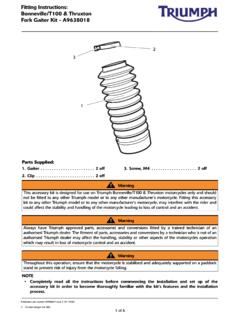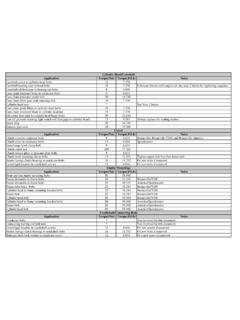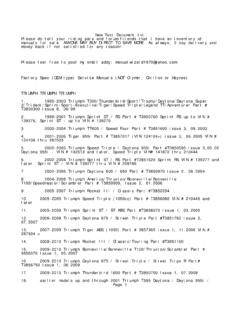Transcription of Tuning Notes for the Triumph “Bonneville” Family of ...
1 Tuning Notes for the Triumph bonneville Family of motorcycles Includes the bonneville , T100, Thruxton, Scrambler, America and Speedmaster - 2001 onwards Version 5: June 2006 Cat No: CTN 01 To order: Phone +44 (0) 1722 711 745 Page 2 About Tuning Why Tune? At Jenks Bolts we get regular enquiries about Tuning the bonneville motor and the best carbu-rettor setup for a particular exhaust system and riding style. As with all modern Triumphs, the parallel twins used in the bonneville Family are set up by the fac-tory to ensure the bike meets all the various per-mits for Type Approval around the world. This means that the carburettors are set to run very lean, so that with the secondary air injection system the simple oxidative catalysts in the stock exhausts will work correctly.
2 The graphs below show the power curves from an early 790cc bonneville , with (blue) and without (red) Triumph off road (TOR) exhausts. The vibra-tion in the blue line at high revs shows that the mix-ture is very lean. The dip in power and torque curves in the mid range is also very noticeable. Fuel injected bikes, with the complex mapping options available, are much easier to optimise: it is a sign of Triumph s skill that they have been able to keep carburettors on the bonneville into the 2006 model year. To get the most from the new Triumph twins it is necessary to fit free flowing exhausts and air filter, re-jet the carburettor and remove the air injection equipment, effectively undoing much of what Tri-umph did to get the bikes legal.
3 There is considerable scope for improvement: over the last five years we have built up a range of set-tings that cover most requirements. The aim is a set up that allows the bike to pull strongly in every gear to the red line, from any throttle position. Snap open full throttle from 4000 rpm in 3rd or 4th should result in an immediate increase in revs, without any hesitation. There should be no obvious flat spot and a smooth even mid range torque. Remember, to optimise setup there is NO substi-tute for an experienced technician with an exhaust gas analyser and a rolling road or Dynamometer. Without proper analysis it is easy to end up with settings that seem OK, but in fact leave the mixture very weak at high revs.
4 We use a local Dynotech facility and encourage you to find one near you but make sure the technician understands carburet-tors: many younger operators don't. Triumph s Twins With the launch of the 2006 model there are, in effect, 6 versions out on the streets. The table on page 10 is based on Triumph s published data and information developed by Jenks Bolts. It shows the stock setup in green text; validated Tuning options in blue; settings reported to us by other riders, but not validated by us, in black and finally provisional information in grey. Take a moment to see where your ride or rides fit into this matrix. What this Booklet Does In this booklet we will: Look at how the CVK carburettor works and how the various jets and needle interact, Examine the Tuning changes that can be made to various parts of the motor, and Bring all the information together with a clear explanation of the changes you can make and what to expect.
5 By following through this booklet you will: Gain a clear understanding of the variation in carburettor settings between the stock models Understand the options that are available for enhancing performance Understand the changes that need to be made to achieve improved performance. Page 3 Understanding Keihin s CVK Basics The CVK carburettor used on the Triumph parallel twins is technically a bleed type carburettor, with a variable venturi that's controlled by a slide that is in turn controlled by the vacuum above the dia-phragm. It's also known as Constant Depression or Constant Vacuum carburettor. The 36 in the name represents a 36 mm venturi exit diameter. Most carburettors have a one piece needle jet. On the CVK36 it consists of 3 parts: a collar, the jet and what Triumph call a holder.
6 Most 4-stroke car-burettor jets have pin holes along the length of the jet or holder. These pin holes allow air from the air jet to premix with fuel from the fuel jet to start the mixture emulsification process before it enters the venturi. The photo below shows the main parts of the main jet and the pilot jet. A venturi is a tube with a convex taper, (one end wider than the other). As air enters the wider end it's squeezed into the narrower section of the tube, lowering air pressure. The area of lowest pressure in the carburettor ven-turi is just past the narrowest point: Bernoulli's Prin-ciple outlines the fluid dynamics involved in this effect. This lowered pressure, known as a comparative vacuum is a completely separate effect from the engine vacuum caused by the piston descending.
7 A variable venturi carburettor is able to vary the ef-fective venturi diameter at the depression point by raising or lowering an obstruction, known as a slide. On a CV carburettor the slide is also known as a piston or diaphragm valve. The following diagram nicely illustrates the main parts of the carburettor. Both the CV and conventional slide carburettors, like Amals, are classified as variable venturi carbs. The slide on a conventional carburettor is directly connected to the throttle cable. Twist the throttle grip and the slide is raised in the venturi. On a CV carburettor the throttle cable is connected to a butterfly valve that varies the volume through the venturi. It's not the throttle, it's the pressure difference from the venturi to the outside atmos-phere that moves the slide.
8 Most carburettor problems boil down to it being either too rich, (too much fuel or too little air), or too lean, (too much air or too little fuel). The mix-ture is theoretically ideal at around 13 parts of air to one part of gasoline/petrol vapour. The outer limits for safe running are between 12:1 and 14:1. Too rich and you're wasting fuel, spewing more pol-lutants, diluting your oil, fouling engine parts, and as a result performance suffers. Too lean and you run the risk of detonation, damage to the valves caused by overheating and performance suffers. An air-cooled engine needs to run richer (more fuel) to aid in engine cooling, which is a further conflict that the Triumph twins have to do with and why their oil system plays such a big part in cooling.
9 The Main Parts We have already mentioned some of the main parts in the CVK, but it is worth looking in some more de-tail at the parts of the carburettor that can change the mixture, as understanding what they do and how they work together is the key to optimising your carburettor settings. Jenks bolts Performance Parts Jenks bolts Performance Parts Page 4 1. The Float The float bowl acts as a fuel reservoir to meet en-gine demand. The float is hinged on a pin in the float boss. It rises and falls with the fuel level in the float bowl. The small metal tang integrated in the plastic float supports the float valve, also known as the float needle. As the fuel in the float bowl rises, the float valve is pushed into the valve seat, until it's high enough to shut off the fuel flow to the bowl.
10 As fuel is used the level in the bowl drops lowering the float which pulls the float valve from its seat, and fills again. Adjust-ing the height of the float has a big effect on the mixture as a low or high float level makes it harder or easier for the vacuum to suck fuel into the ven-turi. Differing float levels cause an imbalance which may be perceived as vibration. 2. The Choke This system is referred to as the choke. But that's a misnomer. When you pull the choke knob, what you're doing is retracting a plunger that opens a tube connected to the starter jet, allowing addi-tional fuel to enter the venturi just below the vac-uum hose nipple. It supplements the pilot system at start up. 3. The Pilot System The primary purpose of the pilot system is to supply the mixture at idle.




